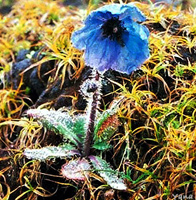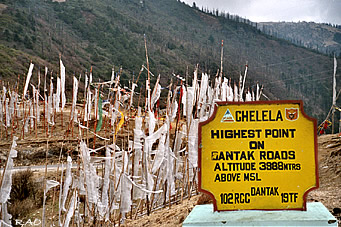| Bhutan's
Nature - Animals |
| Blue
Poppy - National Flower of Bhutan |
 |
Bhutan Nature Plants |
|
 |
Bhutan Information |
|
|
 |
| Chelela blue poppies depleted |
 |
 |
| Blue
poppies, the national flower, that once grew in abundance at the Chelela
pass in Paro has been severely depleted in recent years according to
the Royal Society for the Protection of Nature. "We spotted
only three flowering and two seedlings at Chelela this June and July,"
said the society's ecologist and ornithologist, Rebecca Pradhan. According
to the society there were about 150 blue poppies in the 1990s. In
2000, the number had dwindled to 20 and to 11 in 2002. |
|
The
society feels that the depletion is because of plundering by people from
neighbouring districts with particular interest in gardening. With the
highway going through the pass it is easy for people to go and dig up the
flowers which are about 5 to 10 minutes walk away from the road," said
Rebecca Pradhan.
Small
holes left in the flowering area indicated that people had been digging
up these plants according to the society. The society fears that this species
might be wiped out totally from Chelela. However, no research has been
done and the society does not know the implications it might have on the
ecosystem.
| Of
the four types of blue poppies found in the area, the "Meconopsis
napaulensis" is rare and a total wipe out of the species could lead
to its extinction from that area too. "People do not recognise the different
types of species. Based on their judgement of the colour they recognise
it as blue poppies," said Rebecca Pradhan. To the professional the different
kinds can be differentiated by the characteristics of the plants like the
shape of the leaves, the seed pod or the filament. |
|
 |
"People
like the idea of having the blue poppies in their garden since it's Bhutan's
national flower as well as a rare plant but they should keep in mind
the social responsibility to protect and preserve what is in the country."
"Blue poppies, not even the general garden poppies can grow if they are
transplanted," said Rebecca Pradhan. "The best case would be to sow the
seed."
The
blue poppy is found in the alpine region across the country and Bhutan
has 13 types of Blue poppy of which one is endemic to Bhutan.
The meconopsis
superba is found in Halakyula, Haa and the flowers are white in colour.
This poppy is said to be one and a half metres tall and a plant has an
average of about 30 flowers according to the society. The plant is monocarpic
and it dies after flowering.
The
society has put up a proposal to the government for monitoring the Chelela
area according to the society.
top
| Information on Bhutan |
 |
| Links |
 |
|




